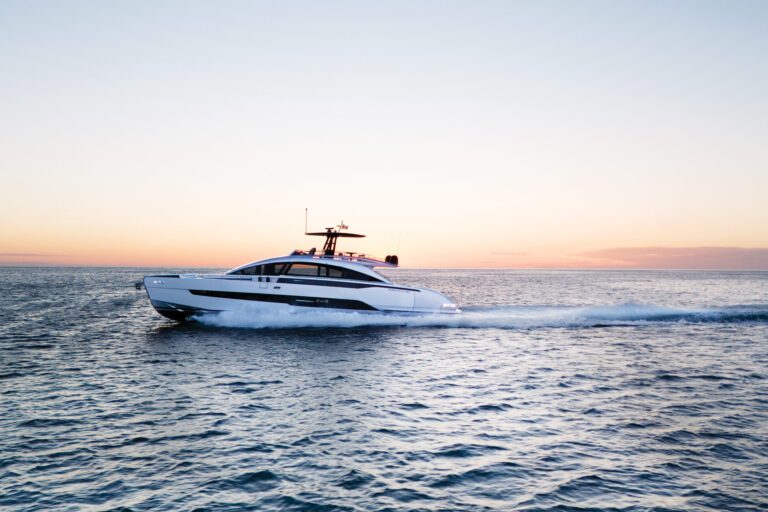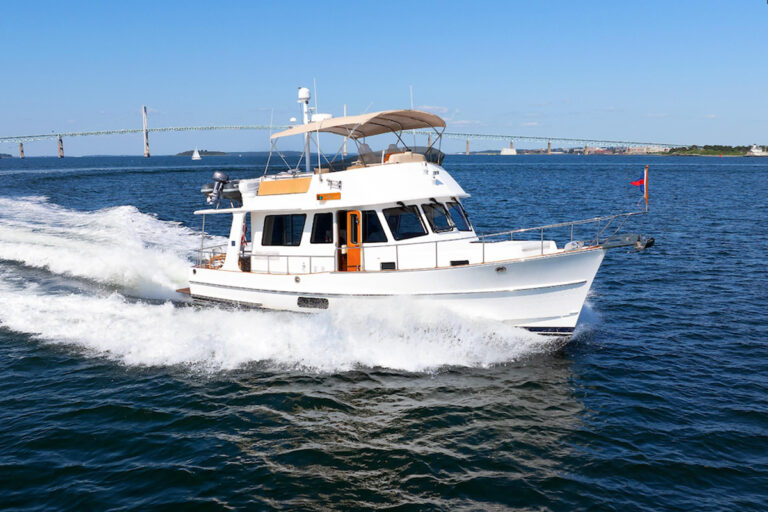An integrated system of electronic instruments and navigational aids requires a source of precise, stable heading data. This is especially true if you have a chart plotter able to display the radar image over the chart. Brooks & Gatehouse has aimed its Halcyon electronic compass squarely at these modern systems. What’s more, the compass functions equally well in all applications and as a standalone heading compass.
The heart of the system is the KVH GyroTrac magnetic sensor. B&G would not have been able to achieve Halcyon’s performance with a conventional magnetic fluxgate sensor. The GyroTrac combines magnetic heading data from its fluxgate with data from solid-state gyro motion sensors to minimize time lag and create stable, highly accurate heading information. It costs less than one-quarter as much as a ship’s gyro and consumes a minor fraction of the power.
If the GyroTrac is the heart of the system, the sunlight-readable, 41/4-inch diagonal monochrome LCD is the soul. Your heading, the primary information, appears in the upper left of the screen in large, bold, easy-to-read numerals. An analog bar graph display just below the heading indicates the magnitude and direction of any deviation from that heading, and the digital value of the heading error shows below the bar graph. Off-course guidance for the helmsman can also be provided from an accessory port-starboard analog meter. Night lighting presents black text on a green or red adjustable-brilliance background.
A set of four mode/data entry push buttons on the right of the display adjacent to on-screen programming and information messages lets the user select from three vessel-related subordinate data choices: sailboat, cruise power and race power. The sailboat mode offers four choices for the subordinate displays: off-course, stored-course, trend and turn rate. The basic off-course mode compares the present heading to the steered value at the time you pressed the “enter” button. The stored-course mode allows the navigator to store as many as 10 courses for a race or voyage. Each can be recalled and used as the reference for display of off-course guidance. The trend function operates much like the normal off-course mode, however, the legends “lift” or “head” indicate whether the vessel is sailing above or below the reference course on the current upwind tack.
The turn mode displays the mean rate of turn or the instantaneous rate in degrees per second. The mean turn rate display is particularly valuable when the vessel’s heading varies above and below the heading you’ve selected. It gives you an indication of how the autopilot is behaving. The trend indication clearly shows the overall bias of the heading error, whether to port or starboard. These features are of particular value to anyone preparing for a sailboat race.
Cruise power is a subset of the sailboat mode. The trend mode is omitted because it has no practical value to a powerboat. Each of the other modes-off course, stored course and turn rate-operate as they do in the sailboat mode. Race power omits the turn mode while allowing the storage and recall of as many as 100 courses. You may, with the push of a button on the display or the remote, select each successive course for the race.
Setup allows you to select the alarm function, sensor damping, sensor angle, operating mode, meter configuration for the accessory analog meter display and heading node (selection of alternate heading information source). The alarm function activates when the heading deviates beyond the “safe sector” value you’ve selected. An off-course alarm will be noticed by anyone in view of the display because the entire screen flashes on and off. It’s particularly effective at night, using the red backlight. Sensor damping allows selective smoothing of heading information to reduce display jitter in rough seas. Changing the damping setting does not alter the fixed twice-per-second data update rate. The sensor angle setting allows entry of a fixed offset angle to compensate for any difference between the longitudinal axis of the sensor and the vessel. This value, once set, needs to be altered only if the sensor is disturbed.
Automatic deviation correction is simple and effective. The sensor’s dimensions of 61/2 inches long and 41/4 inches square make it easy to install. The main processor measures 9 by 51/2 by 31/4 inches. Its terminal strip is clearly marked and easy to wire. Because it contains no user controls, it can be located anywhere. The EEPROM memory retains data when power is removed. Power consumption is modest, 0.025A without lighting, 0.090A with lights on bright. The microprocessor provides a number of self-test diagnostic modes.
During our use of the Halcyon, we found the use of the term “course” for heading confusing. Except in still air, zero current, the heading and course are not identical. This minor misuse of the term “course” comes from the use of the term to specify the legs of a sailing race.
The off-course (off-heading) guidance provided by the small bar graph on the LCD could be improved by instead depicting a large Port-Starboard analog indicator on the screen. This would let the helmsman keep the indicator pointing straight up. A tired helmsman will respond better to the prompting of a bold “Port-Starboard” command pointer than to a page of numerals and a small bar graph.
Contact: B & G; www.bandg.com





